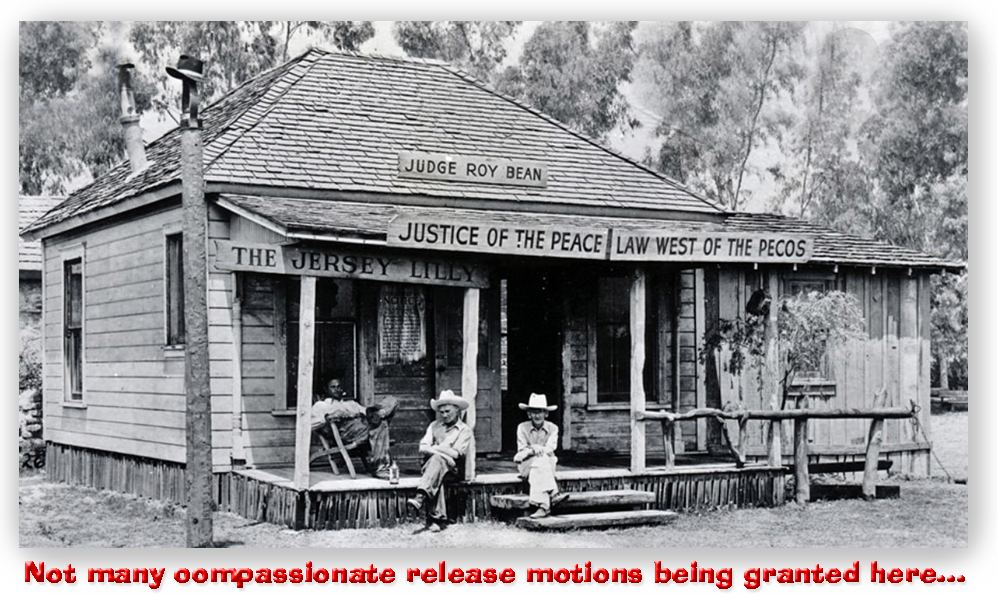We post news and comment on federal criminal justice issues, focused primarily on trial and post-conviction matters, legislative initiatives, and sentencing issues.

NUMBED BY NUMBERS
 The U.S. Sentencing Commission recently issued an updated report on compassionate release, covering all of the filings since October 1, 2019 (six months before the pandemic began) through last March.
The U.S. Sentencing Commission recently issued an updated report on compassionate release, covering all of the filings since October 1, 2019 (six months before the pandemic began) through last March.
In 30 months, we learn, 25,416 motions were filed, with 16.7% (4,234) granted. Good to know for this weekend’s cocktail-party chatter, but functionally useless.
Most people currently filing 18 USC § 3582(c)(1)(A)(i) sentence reduction motions – inaccurately but generally known as “compassionate release” motions – don’t care about the 30-month average. What courts were doing in the few months prior to the pandemic – or, for that matter, in the early pandemic when COVID raged and everyone was scared – has hardly any relevance to what they are doing today. People want to know what has been happening in the last few months (last March, for example, 13.4% of 479 motions were granted).
We do learn that over the 30 months studied, Eastern District of Texas (2.6%), Southern District of Georgia (2.2%) and Middle District of Georgia (1.7%) were the worst places to get relief. The best places to be remain locations such as California (except the Eastern District) at 35.8%, Kansas at 41.9%, Connecticut at 37.2%, Massachusetts at 44.8% and Oregon at 59%.
Some districts have even better numbers, but the number of motions filed in those jurisdictions is so small as to make the grant/denial percentage in those districts meaningless.
My problem with the data is this: Given the waning pandemic, the position taken by some circuits that inmate vaccination disqualifies the risk of COVID as a basis for compassionate release, and the decision by almost all circuits that USSG § 1B1.13 does not limit the groups that may be raised in an inmate-filed compassionate release motion, how district courts may be acting on compassionate release motions today may bear scant resemblance to what was being done, say, in April 2020. That being the case, it is tough to take away much from a comparison of a judicial district’s grant rate over a 30-month period. A period of six to 12 months would make a lot more sense.
I am surprised by some commentators bemoaning the fact that there are wide disparities among the districts. That’s what happens when federal judges are permitted to exercise almost unbridled discretion. Ohio State law professor Doug Berman, writing in his Sentencing Law and Policy blog, complained that
perhaps most striking data points are the dramatic variations in grant rates from various districts. As but one of many remarkable examples, I must note again the stark disparities in the three districts of Georgia: the Southern District of Georgia granted only 6 out of 272 sentence reduction motions for a 2.2% grant rate; the Middle District of Georgia granted only 4 out of 238 sentence reduction motions for a 1.7% grant rate; but the Northern District of Georgia granted 80 out of 174 sentence reduction motions for a 46% grant rate.
One commenter to Berman’s post responded, “When you tell judges they can do whatever they care to, without any standards that are going to get enforced, this is what you’re going to get. Any resemblance between this and ‘Equal Justice Under Law’ is strictly coincidental.”
 Maybe so, but “standards that are going to get enforced” sounds a lot like the bad old days of mandatory guidelines. You can’t have it both ways. Judges exercising a lot of discretion can take individual factors into account the way that uniform standards applying across all 94 federal districts cannot. On the other hand, standards can limit the baser instincts of the Judge Roy Beans of the federal judiciary.
Maybe so, but “standards that are going to get enforced” sounds a lot like the bad old days of mandatory guidelines. You can’t have it both ways. Judges exercising a lot of discretion can take individual factors into account the way that uniform standards applying across all 94 federal districts cannot. On the other hand, standards can limit the baser instincts of the Judge Roy Beans of the federal judiciary.
Perhaps our newly-reconstituted Sentencing Commission can find a happy (pro-defendant) medium.
U.S. Sentencing Commission, Compassionate Release Data Report (Fiscal Years 2020 to 2022)
Sentencing Law and Policy, US Sentencing Commission releases latest “Compassionate Release Data Report” with detailed data through March 2022 (September 12, 2022)
– Thomas L. Root

